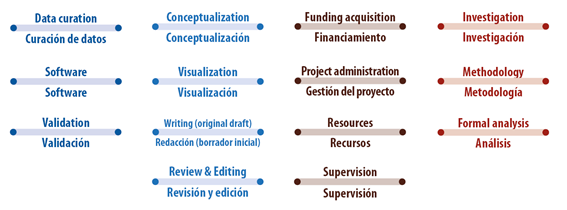Submissions
Submission Preparation Checklist
All submissions must meet the following requirements.
The file sent is in OpenOffice, Microsoft Word, RTF, Word para Mac, WordPerfect format
Verify if it counts with a right of use for all images, figures, tables, illustrations, maps, diagrams or others in the work (if the case be)
- The article has not been simultaneously postulated for publication before another printed journal, electronic or in any other written medium or editorial organization (or explanations provided in Comments to the editor)
- The text follow the APA regulations, for citations, references, tables and figures. This regulations are specified in the Author Guidelines of the Journal.
- A cover letter joined to the manuscript *Attach this document in the supplementary files section
- The text of the manuscript must be presented in a letter-sized document, with a number on each line, with simple line spacing (including references), Times New Roman font 12 points for the entire text, margins of 2.54cm (1 inch) on all four sides of each sheet, justified on both sides, to a single column, containing Figures and Tables in the precise places. The recommended extension should not exceed 7000 words including Figures, Tables and bibliographic references. The pages should be numbered consecutively with the numbers in the lower right corner.
- DOI or PMID have been added for the bibliographic references
- The manuscript follow Publication Norms of the Journal
- Report whether your article has a preprint version.
- You must state the type of participation of each co-author of the article based on the CREDIT taxonomy.
Scientific Articles
Original scientific articles, bibliographical and systematic reviews, and meta-analysis in the different areas related to the Human Movement Sciences and Health will be published in this section. In addition to the publication of systematized practical experiences.
The period is currently open for submitting manuscripts
Bibliographic Review
- Plantea una revisión bibliográfica de un determinado ámbito de estudio relacionado con la temática que la Revista aborda.
- Puede repasar los expositores más relevantes, sus ideas principales y sus aportes.
- Puede hacer un análisis y comentarios basados en afirmaciones objetivas y sustentadas.
- El capítulo de la investigación relativo al “estado de la cuestión” puede constituirse en un artículo de esta índole.
Systematized Practical Experiences
- Se deriva de una experiencia práctica o didáctica.
- Refiere los alcances de la experiencia y los pendientes.
- Debe plantear los objetivos, describir las estrategias utilizadas y los resultados de la parte escogida para compartir en la Revista.
- Debe expresar sus propios propósitos y mostrar independencia respecto de la del proyecto o experiencia que lo sustenta. Esto es, debe manifestar autosuficiencia semántica.
Systematic review
- Evaluaciones críticas y exhaustivas del material ya publicado. Se considera que el organizar, integrar y evaluar el material publicado permite considerar el avance de la investigación actual para la clarificación de un problema.
- Consideran un método sistemático para la búsqueda de todos los estudios analizados.
- Considera la formulación de la pregunta de la revisión.
- Sintetizan investigaciones previas, informando al lector acerca del estado del conocimiento en el área de estudio en cuestión.
- Identifican relaciones, contradicciones, lagunas e inconsistencias en la literatura.
- Proponen los pasos siguientes en la solución de un problema.
Para este tipo de colaboración debe aportar el número de registro en la base Próspero (International Prospective Register of Systematic Reviews).
Meta-analysis
- Son evaluaciones críticas y exhaustivas del material ya publicado. Se considera que el organizar, integrar y evaluar el material publicado permite considerar el avance de la investigación actual para la clarificación de un problema.
- Consideran un método sistemático para la búsqueda de todos los estudios analizados.
- Definen y clarifican el problema.
- Sintetizan investigaciones previas, informando al lector acerca del estado del conocimiento en el área de estudio en cuestión.
- Combina los resultados de los estudios seleccionados mediante técnicas estadísticas.
- Identifican relaciones, contradicciones, lagunas e inconsistencias en la literatura.
- Proponen los pasos siguientes en la solución de un problema.
Essay
- Documento científico que presenta una perspectiva analítica, reflexiva, interpretativa o crítica de quien escribe acerca de una postura, una hipótesis, un abordaje sobre determinada teoría o temática. Para ello, se apoya de otros referentes teóricos (literatura científica o académica), los cuales utiliza para validar o cuestionar una posición.
- En su contenido, deberá establecer una jerarquización de apartados que guíe en su lectura y oriente la comprensión de los argumentos.
Copyright Notice
General conditions
MHSalud: Journal in Human Movement Sciences and Health by the Universidad Nacional is cover under a Creative Commons Atribución-NoComercial-SinDerivadas 3.0 Costa Rica license.
The journal is hosted in open access repositories such as the Institutional Repository of the Universidad Nacional, the Kimuk Repository of Costa Rica and La Referencia.
The editorial source of the journal must be recognized. Use the doi identifier for this purpose.
Self-archiving policy: The journal allows the self-archiving of the articles in their peer-reviewed version, edited and approved by the Editorial Board of the Journal to be available in Open Access through the Internet. More information in the following link: https://v2.sherpa.ac.uk/id/publication/25815
Privacy Statement
The names and e-mail addresses registered in the Journal’s system will be exclusively used for the stated objectives and not available for any other purpose or person.



















